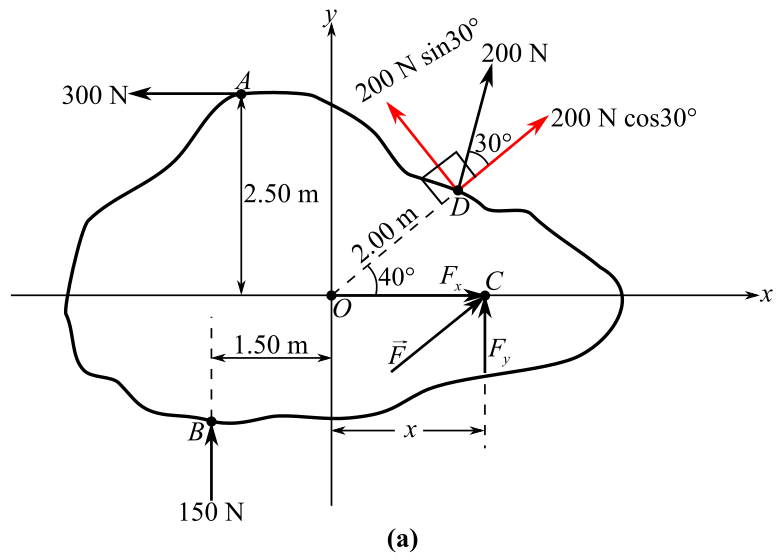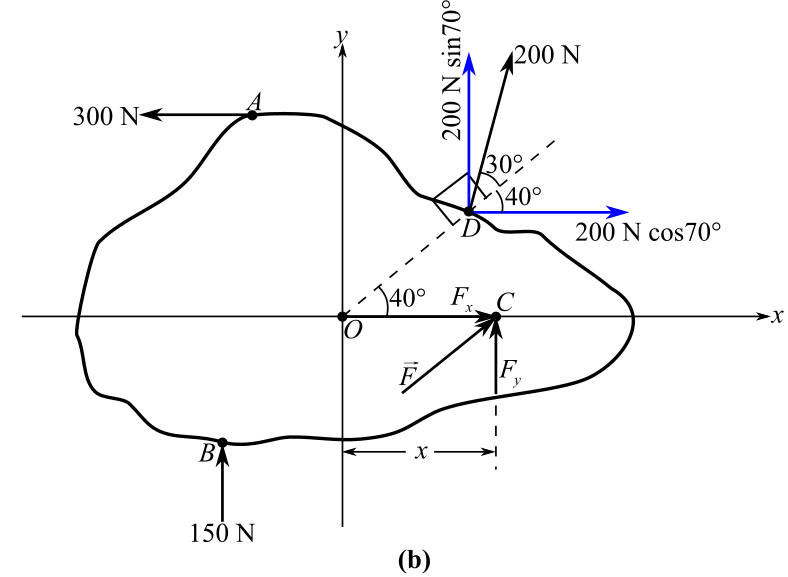
Concept explainers
An object is subjected to the forces shown in Fig. 5-25. What single force F applied at a point on the x-axis will balance these forces leaving the object motionless? (First find its components, and then find the force.) Where on the x-axis should the force be applied? Notice that before F is applied there is an unbalanced force with components to the left and upward.
![Chapter 5, Problem 36SP, 5.36 [III] An object is subjected to the forces shown in Fig. 5-25. What single force F applied at](https://content.bartleby.com/tbms-images/9781259587399/Chapter-5/images/87399-5-36sp-question-digital_image123.png)
Fig. 5-25
The magnitude of the applied force and direction of that force on the
Answer to Problem 36SP
Solution:
Explanation of Solution
Given data:
Refer to theFigure
Formula used:
From the parallelogram law of vector addition, if the expression of resultant force is written as
The magnitude of
Here,
The direction of
Write the expression for the first condition of force equilibrium:
Here,
Write the expression for torque:
Here,
Explanation:
Draw the free body diagram of the system:

In the above diagram,
Refer the above figure, recall the expression of torque:
Apply the equation for torque at point
Further solving the equation for
Draw the free body diagram of the system when resolving the force of

In the above diagram,
Consider theFigure (b)and recall the expression for the first condition of the force’s equilibriumin the x-direction:
Consider the direction of the rightward forces to be positive and the direction of the leftward forces to be negative. Therefore,
Rewrite the expression for the first condition of force equilibrium in the y-direction.
Consider the direction of the upward forces to be positive and the direction of the downward forces to be negative. Therefore,
The negative sign shows the direction of the force is downward.
Recall the expression for the magnitude of the resultant force:
Substitute
Recall the expression for the direction of the resultant force:
Substitute
Rewrite equation(1)
Substitute
Conclusion:
The value of the horizontal force
Want to see more full solutions like this?
Chapter 5 Solutions
Schaum's Outline of College Physics, Twelfth Edition (Schaum's Outlines)
- Logs weighing 1.3 kg and 2.2 kg lie on a flat surface and are connected by a rope that breaks at a force of 20 N. The coefficient of friction between the lighter log and the base is 0.50, and between the heavier log and the base 0.30. With what maximum force can we pull the lighter log so that the string does not break?arrow_forwardA block of mass 4.20 kg is pushed up against a wall by a force P that makes an angle of θ = 50.0°angle with the horizontal as shown below. The coefficient of static friction between the block and the wall is 0.270.arrow_forwardA 1.50×103 kg car, whose front is facing to the right (towards +x-axis) and whose engine is turned off and in neutral, is held at rest on a frictionless ramp using a cable whose one end is attached to the car’s front at an angle 27.0◦ with respect to the ramp’s surface. The other end of the cable is attached to a wall perpendicular to the horizontal and the ramp is raised 30.0◦ above the horizontal. b. Find the tension on the cable.arrow_forward
- The mass of a block in a 53.1 degree inclined plane is 20 kgs. The coefficient of kinetic friction between the block and the incline is 0.40 . What must be the mass of the hanging block if it is to descend 12.0 m in the first 3.00 s after the system is released from rest?arrow_forwardA block weighing 100N is held on a 40˚ incline by a bar attached to a 150N block on a horizontal plane. The bar, which is fastened by smooth pins at each end, is inclined 20˚ above the horizontal. The angle of friction between each block and its plane is 18˚. Find the horizontal force P applied to the 150N block which will cause to be on the point of moving (a) to the right; (b) to the leftarrow_forwardYou are holding a book of mass 10.7 kg that is initially at rest against a vertical wall by exerting a force of magnitudeF Yb = 100.8 N at an angle of θ = 34.7 degrees, as indicated in the figure.If the coefficients of friction between the book and the wall are μs = 0.46 and μk = 0.36, find the magnitude of thefrictional force from the wall on the book.arrow_forward
- An 85 kg man tries to pull himself up the face of a boulder using a rope hooked to a tree above it. The face of the boulder created a 50.0° angle with the horizontal. If the coefficient of friction between his shoes and the boulder is 0.350, will he make it up if he pulls with 550. N of force? Remember his shoes will try to slip backwards when considering friction.arrow_forwardThe figure below shows a crate with a mass of m = 4.00 kg on a ramp inclined at an angle of 35.0°. The coefficient of static friction between the crate and the ramp is 0.260. Find the minimum magnitude of the force F (in N), applied to the crate in a direction perpendicular to the ramp, that will prevent the crate from sliding down the ramp. A rectangular crate of mass m is positioned on an inclined ramp of angle 35.0° (measured counterclockwise from the horizontal). A force, vector F, is applied down and right on the crate, perpendicular to the incline.arrow_forwardA 100 kg block is at rest on a flat floor with a coefficient of static friction 0.62. A horizontal force of 3.7 N is applied to the block, but it does not budge. What is the magnitude of the frictional force on the block applied?arrow_forward
- The block shown in the figure is along a frictionless horizontal surface The block's mass is m = 4.70 kg , the magnitude of the applied force is F= 26.5N, and the angle of the applied force from the horizontal is theta = 26.0 degrees. What is the magnitude of the normal force acting on the block.arrow_forwardA small box is held in place against a rough wall by someone pushing on it with a force directed upward at an angle of 260 above the horizontal. The coefficient of static and kinetic friction between the box and the wall are 0.40 and 0.30, respectively. The box slides down unless the applied force has a magnitude of 13 N. What is the mass of the box?arrow_forwardA block of mass m= 13.5 kg rest on inclined plane with the coefficient of static friction of us= 0.12 between the block in the plane. The inclined plane is L= 6.3 m long and it has a height of h= 3.8 m at its tallest point. What angle, Θ in degrees, does the plane make with respect to the horizontal? What is the magnitude of the normal force, Fn in Newton’s, that acts on the block? What is the component of the force of gravity along the plane, Fgx in Newton’s? Will the block slide?arrow_forward
 Physics for Scientists and Engineers: Foundations...PhysicsISBN:9781133939146Author:Katz, Debora M.Publisher:Cengage Learning
Physics for Scientists and Engineers: Foundations...PhysicsISBN:9781133939146Author:Katz, Debora M.Publisher:Cengage Learning
